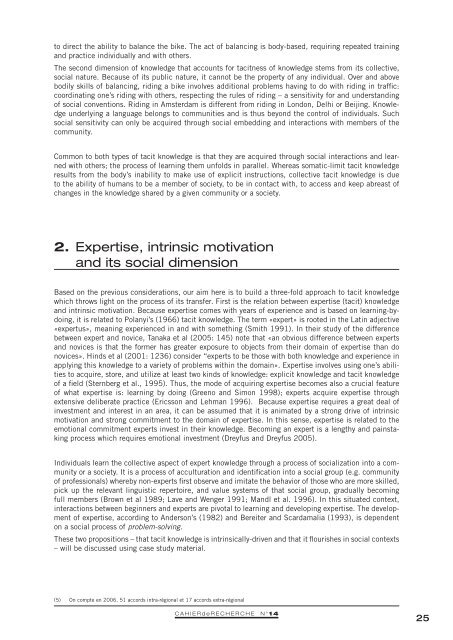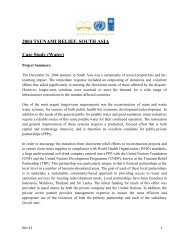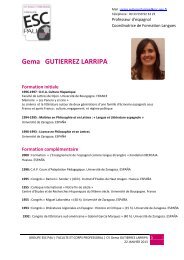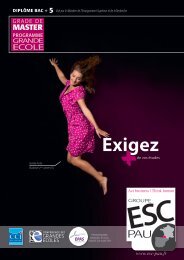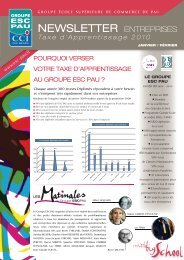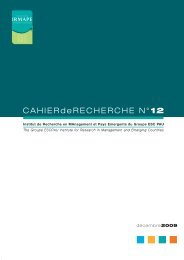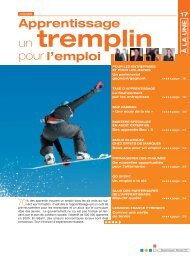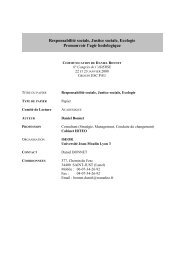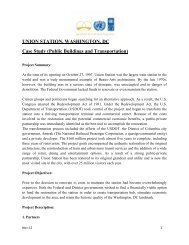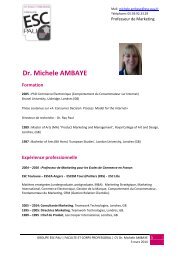to direct the ability to balance the bike. The act of balancing is body-based, requiring repeated trainingand practice individually and with others.The second dimension of knowledge that accounts for tacitness of knowledge stems from its collective,social nature. Because of its public nature, it cannot be the property of any individual. Over and abovebodily skills of balancing, riding a bike involves additional problems having to do with riding in traffic:coordinating one’s riding with others, respecting the rules of riding – a sensitivity for and un<strong>de</strong>rstandingof social conventions. Riding in Amsterdam is different from riding in London, Delhi or Beijing. Knowledgeun<strong>de</strong>rlying a language belongs to communities and is thus beyond the control of individuals. Suchsocial sensitivity can only be acquired through social embedding and interactions with members of thecommunity.Common to both types of tacit knowledge is that they are acquired through social interactions and learnedwith others; the process of learning them unfolds in parallel. Whereas somatic-limit tacit knowledgeresults from the body’s inability to make use of explicit instructions, collective tacit knowledge is dueto the ability of humans to be a member of society, to be in contact with, to access and keep abreast ofchanges in the knowledge shared by a given community or a society.2. Expertise, intrinsic motivationand its social dimensionBased on the previous consi<strong>de</strong>rations, our aim here is to build a three-fold approach to tacit knowledgewhich throws light on the process of its transfer. First is the relation between expertise (tacit) knowledgeand intrinsic motivation. Because expertise comes with years of experience and is based on learning-bydoing,it is related to Polanyi’s (1966) tacit knowledge. The term «expert» is rooted in the Latin adjective«expertus», meaning experienced in and with something (Smith 1991). In their study of the differencebetween expert and novice, Tanaka et al (2005: 145) note that «an obvious difference between expertsand novices is that the former has greater exposure to objects from their domain of expertise than donovices». Hinds et al (2001: 1236) consi<strong>de</strong>r “experts to be those with both knowledge and experience inapplying this knowledge to a variety of problems within the domain». Expertise involves using one’s abilitiesto acquire, store, and utilize at least two kinds of knowledge: explicit knowledge and tacit knowledgeof a field (Sternberg et al., 1995). Thus, the mo<strong>de</strong> of acquiring expertise becomes also a crucial featureof what expertise is: learning by doing (Greeno and Simon 1998); experts acquire expertise throughextensive <strong>de</strong>liberate practice (Ericsson and Lehman 1996). Because expertise requires a great <strong>de</strong>al ofinvestment and interest in an area, it can be assumed that it is animated by a strong drive of intrinsicmotivation and strong commitment to the domain of expertise. In this sense, expertise is related to theemotional commitment experts invest in their knowledge. Becoming an expert is a lengthy and painstakingprocess which requires emotional investment (Dreyfus and Dreyfus 2005).Individuals learn the collective aspect of expert knowledge through a process of socialization into a communityor a society. It is a process of acculturation and i<strong>de</strong>ntification into a social group (e.g. communityof professionals) whereby non-experts first observe and imitate the behavior of those who are more skilled,pick up the relevant linguistic repertoire, and value systems of that social group, gradually becomingfull members (Brown et al 1989; Lave and Wenger 1991; Mandl et al. 1996). In this situated context,interactions between beginners and experts are pivotal to learning and <strong>de</strong>veloping expertise. The <strong>de</strong>velopmentof expertise, according to An<strong>de</strong>rson’s (1982) and Bereiter and Scardamalia (1993), is <strong>de</strong>pen<strong>de</strong>nton a social process of problem-solving.These two propositions – that tacit knowledge is intrinsically-driven and that it flourishes in social contexts– will be discussed using case study material.(5) On compte en 2006, 51 accords intra-régional et 17 accords extra-régionalCAHIER<strong>de</strong>RECHERCHE N°1425
3. Oil Explore: A Case IllustrationIn this research, a case study is <strong>de</strong>emed suitable for exploring the research question, namely the relationshipbetween intrinsically-motivated tacit knowledge and its transfer – a question that has not beena<strong>de</strong>quately addressed in the literature. Case study methodology is able to provi<strong>de</strong> qualitative data thatoffer ‘insight into complex social processes that quantitative data cannot easily reveal’ (Eisenhardt andGraebner 2007: 26). Because the nature of this research is somewhat theoretical sampling is appropriate,which means that the case is selected because it is particularly suitable for illuminating an<strong>de</strong>xtending the relationship among constructs (Eisenhardt and Graebner 2007).To this effect, our empirical site involves an international oil company (pseudonymously referred to asOil Explore (OE). OE is one of the four world largest international oil companies. With operations in morethan 130 countries, OE engages in all aspects of the petroleum industry, including upstream operations(oil and gas exploration, <strong>de</strong>velopment and production, LNG) and downstream operations (refining, marketingand the trading and shipping of cru<strong>de</strong> oil and petroleum products). The company also producesbase chemicals (petrochemicals and fertilizers) and specialty chemicals for the industrial and consumermarkets (rubber processing, adhesives, resins and electroplating). The company has also interests in thecoal mining and power generation sectors. It is also <strong>de</strong>veloping renewable energies, such as wind andsolar power, and alternative fuels. The company employs 96000 persons; in 2006, its sales were aboutbillion 154 Euros. The net income was about billion 12.6 Euros for the same year, the larger part of itcoming from its «upstream» activities (Annual Report 2006).The company intends to ensure its competitiveness by: 1) paying careful attention to safety and environmentalprotection; 2) pursuing an investment strategy aimed at profitable organic growth; 3) leveragingits top expertise in high-growth sectors (<strong>de</strong>ep offshore, LNG, heavy cru<strong>de</strong>s) and implementing a wi<strong>de</strong>-ranginghuman-resources program emphasising diversity at the managerial level; and finally 4) maintaininggood geographic diversity of both reserves and production.One of its competitive advantages lies in its geoscientists’ ability to discover new reserves as efficientlyas possible (Annual Report 2006). The company is very <strong>de</strong>pen<strong>de</strong>nt on the long-term knowledge of itsexperts - tacit knowledge that is internally accumulated through years of experience. This expertise lifecycleis fairly stable over a time span of about 30 years. Within the strategic geosciences division, whichis the focus of our study, geophysicists, geologists and reservoir engineers are consi<strong>de</strong>red knowledgeworkers. Their work can be <strong>de</strong>scribed in the following way: geophysicists produce and interpret un<strong>de</strong>rgroundimages of the earth. Geologists analyze how the petroleum system is formed and the features ofthe un<strong>de</strong>rground. The reservoir engineers <strong>de</strong>termine the dynamic properties of the reservoir to predictthe behavior of a petroleum field, optimize its production and compute its reserves. A Wrong Decision -such as drilling a well that proves unproductive – incurs several millions of Euros. Consequently, experts’knowledge is highly valued. The average age of these experts is over 50 and many of them will retire inthe next 10 years. Their expertise is acquired through <strong>de</strong>ca<strong>de</strong>s of practice and learning by doing. Facingthis imminent mass retirement, the company is un<strong>de</strong>rtaking a number of training programs and numerousefforts facilitate the transfer of expertise to younger generation. To these ends, the geo-science divisionorganizes work processes in project-based and cross-age teams. Experts are taking a leading role, assumingthe responsibility for teaching, transferring their expertise and guiding the novices. Our focus is thuson a number of these experts in or<strong>de</strong>r to un<strong>de</strong>rstand this transfer of tacit knowledge.26CAHIER<strong>de</strong>RECHERCHE N°14
- Page 1 and 2: CAHIERdeRECHERCHE N°14Institut de
- Page 4: SommaireComment classer les actionn
- Page 7 and 8: RésuméA l’origine, la théorie
- Page 9 and 10: influence via un contrôle externe
- Page 12 and 13: La très grande richesse des travau
- Page 14 and 15: a prévalu pendant de nombreuses an
- Page 16 and 17: Lorsque l’actionnariat a majorita
- Page 18 and 19: ConclusionAinsi, il existe différe
- Page 20 and 21: Huynh, Q. T. (2009), L’influence
- Page 22 and 23: Intrinsic Motivation,Tacit Knowledg
- Page 24 and 25: IntroductionAlthough the importance
- Page 28 and 29: The empirical material is elicited
- Page 30 and 31: on after I am gone. It is of no use
- Page 32 and 33: ReferencesAnderson JR (1982), “Ac
- Page 34 and 35: CAHIERdeRECHERCHE N°1433
- Page 36 and 37: University Corporate Governancein t
- Page 38 and 39: of expertise, workload, unpaid time
- Page 40 and 41: 3. Scenario PlanningUncertainty is
- Page 42 and 43: 6. Risk GovernanceRisk governance i
- Page 44 and 45: ReferencesBaird, J. (2007) ‘Takin
- Page 46 and 47: CAHIERdeRECHERCHE N°1445
- Page 48 and 49: Une analyse de la gestionde la perf
- Page 50 and 51: I. Les outils de gestion de la perf
- Page 52 and 53: définissant les finalités des act
- Page 54 and 55: Pour trois-quarts des collectivité
- Page 56 and 57: Au-delà de leur relative nouveaut
- Page 58 and 59: 2. Une mise en œuvre opérationnel
- Page 60 and 61: Or, une démarche de performance se
- Page 62 and 63: 3. L’adaptation du système local
- Page 64 and 65: esponsabilisation et d’évaluatio
- Page 66 and 67: I. NONAKA, “A dynamic theory of o
- Page 68: PROGRAMME GRANDE ÉCOLE, GRADE MAST


